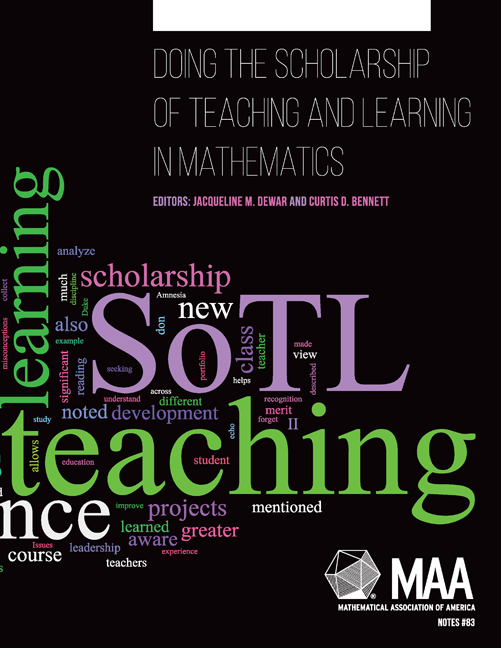Book contents
- Frontmatter
- Contents
- Foreword
- Preface
- Part I Getting Started in SoTL as a Mathematician
- Part II Illustrations of SoTL Work in Mathematics
- Theme 1: Experiments with Approaches to Teaching
- 5 Assessing the Effectiveness of Classroom Visual Cues
- 6 (Re)discovering SoTL Through a Fundamental Challenge: Helping Students Transition to College Calculus
- 7 A Quantitative and Qualitative Comparison of Homework Structures in a Multivariable Calculus Class
- 8 Playing Games to Teach Mathematics
- 9 Investigating How Students' Linking Historical Events to Developments in Mathematics Changed Engagement in a History of Mathematics Course
- Theme 2: Crafting Learning Experiences around Real-World Data or Civic Engagement
- Theme 3: Using Assigned Reading Questions to Explore Student Understanding
- Theme 4: Exploring Student Understanding of the Nature of Mathematics
- Theme 5: Tackling Large Questions
- Epilogue
- Index
5 - Assessing the Effectiveness of Classroom Visual Cues
from Theme 1: - Experiments with Approaches to Teaching
- Frontmatter
- Contents
- Foreword
- Preface
- Part I Getting Started in SoTL as a Mathematician
- Part II Illustrations of SoTL Work in Mathematics
- Theme 1: Experiments with Approaches to Teaching
- 5 Assessing the Effectiveness of Classroom Visual Cues
- 6 (Re)discovering SoTL Through a Fundamental Challenge: Helping Students Transition to College Calculus
- 7 A Quantitative and Qualitative Comparison of Homework Structures in a Multivariable Calculus Class
- 8 Playing Games to Teach Mathematics
- 9 Investigating How Students' Linking Historical Events to Developments in Mathematics Changed Engagement in a History of Mathematics Course
- Theme 2: Crafting Learning Experiences around Real-World Data or Civic Engagement
- Theme 3: Using Assigned Reading Questions to Explore Student Understanding
- Theme 4: Exploring Student Understanding of the Nature of Mathematics
- Theme 5: Tackling Large Questions
- Epilogue
- Index
Summary
Editors' Commentary
This chapter illuminates some of the research design issues discussed in Chapter 3. It shows how the authors developed and piloted a novel intervention, visual cues, during one semester and fully implemented and assessed it in another. The methodology involved two sections of the same course, taught by the same instructor, one as an experimental group and the other as control group. Because using visual cues to assist with some computational skills was specific and limited in scope, many of the concerns mentioned about using control groups in Chapter 3 did not arise. The study involved similar interventions with visual cues in two different settings (first in remedial math, then in calculus). For calculus, the authors discovered that they had to alter their rubric to capture the information they wanted.
Introduction
The large number of students who must take remedial mathematics courses is a problem for many colleges and universities. The courses must be staffed, and students who place into remedial courses are less likely to successfully complete a degree (Attewell, Lavin, Domina, & Levey, 2006). Remediation has been a problem for decades (see, for instance, Handel & Williams, 2011; Patterson & Sallee, 1986; Weiss & Nguyen, 1998). In many lower division mathematics courses the focus of instruction is often on procedural skills. Students should view these courses as an opportunity to improve their skills, but they often see them as hurdles that do not count towards degree completion. The material in remedial courses is often familiar to students, which can make it more difficult for students to expend the time and effort required to correct previous misconceptions. Conversations about our frustrations with these courses led us to consider what we could do to be more effective in teaching procedural skills. The resulting investigation took the form of a What works? study.
We began with an intermediate algebra course, as it involves procedural skills that students have encountered previously. In investigating a What works? question, there are many possible approaches (Patterson & Sallee, 1986).
- Type
- Chapter
- Information
- Publisher: Mathematical Association of AmericaPrint publication year: 2014

